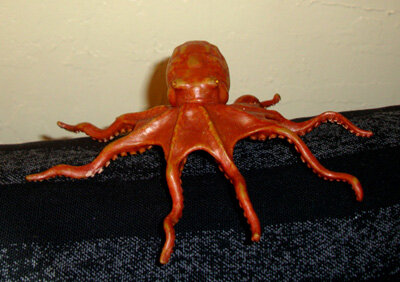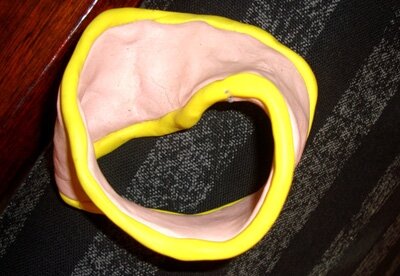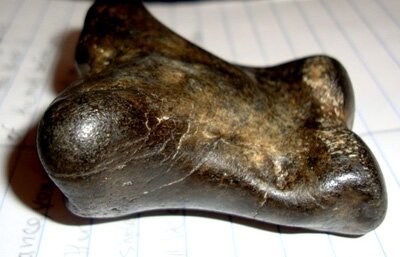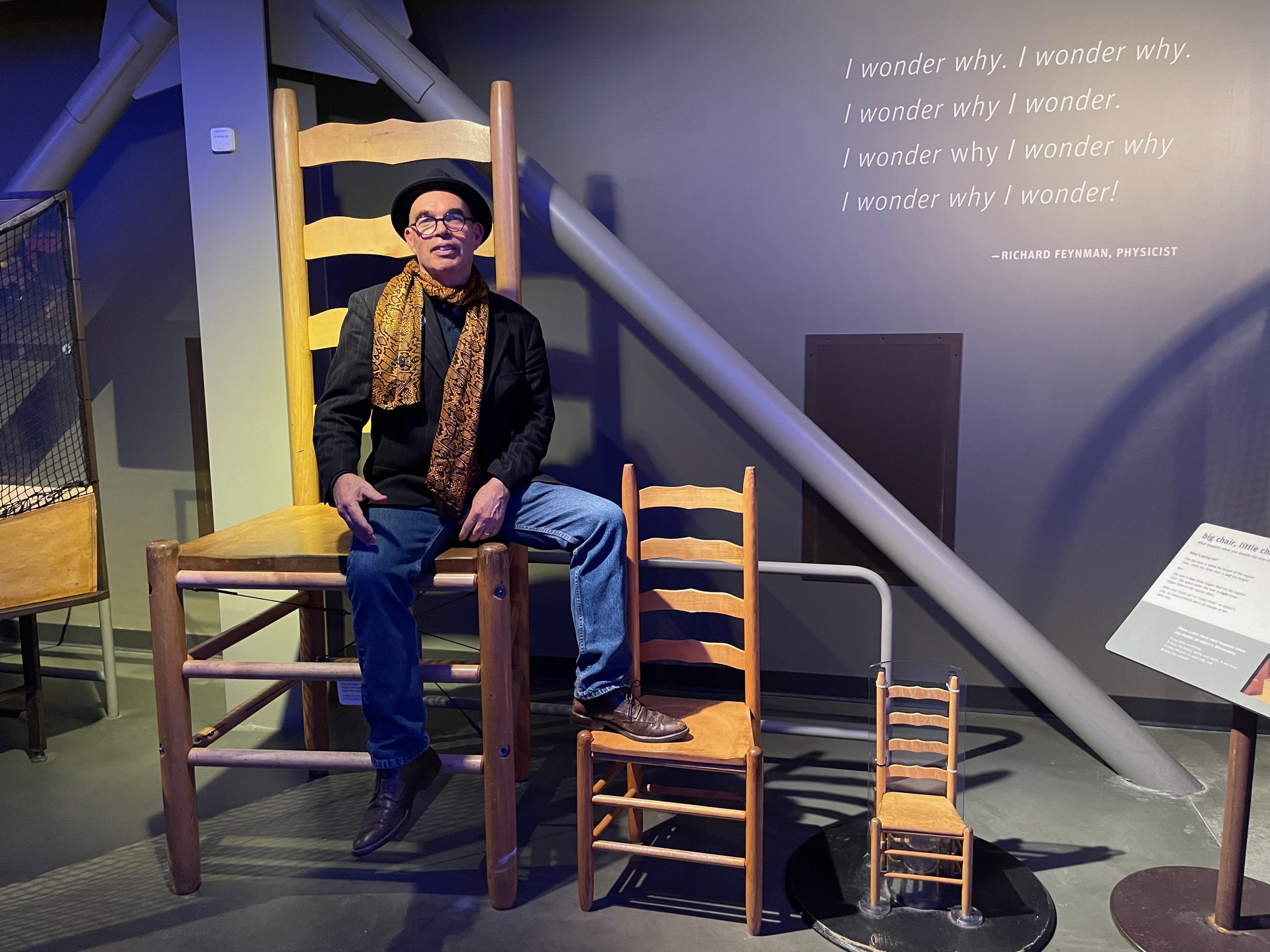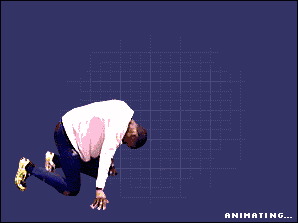TOK ENDGAME:
TOK EXHIBITION
A jpeg of this image of a real life object could be included in a student TOK Exhibition.
Infant macaque in a “Nature of Love” deprivation experiment conducted by experimental psychologist Harry Harlow in the early 1960s. Photo: Martin Rogers / Getty Images
FORESHADOWING THE TOK EXHIBITION —
ReVISITING our very first TOK class
The very first TOK class presented on this website was Explore mystery objects by touch alone. The conceit was to jump right in and do TOK, before any introductions are made or ground rules established. The slogan that captures the spirit of this is “Ready, Fire... Aim!”
Secreted in pillows were a plastic toy octopus, a Möbius strip made of molding clay, and a fossilized equine knuckle bone from Patagonia, that could be convincingly passed off as an ancient human torso sculpture. The choice of three specific, real-world objects was, of course, a foreshadowing of the TOK Exhibition.
FIGS REVISITED
Also in the Starting TOK activities students tackled Figs viewed from multiple perspectives. This activity was conceived to introduce the TOK Exhibition and the TOK Essay. Thinking about the humble fig in eight contrasting knowledge domains modeled the power of seeing things from more than one perspective.
In the TOK Exhibition there is enormous latitude in the form and choice of Objects—but they must be non-generic, tangible, and pre-existing in the real world.
In similar vein, the arguments in TOK Essays must be instantiated—they are “effectively supported by specific examples.”
CLASS ACTIVITY I:
SETTING THE FRAME—EXHIBITION ESSENTIALS
The TOK Exhibition Internal Assessment (IA) is completed by the end of the first year. Eight hours of teaching time are recommended.
The TOK Exhibition “explores how TOK manifests in the world around us.” It consists of a curated exhibition of three real world objects that connect to one of 35 IA Prompts. The Prompts are all very broad, open-ended knowledge questions. Download the prompts in advance from the TOK Subject Guide. Share them with students during this introductory session.
Force-feeding equipment from Walton Gaol, Liverpool.
Force-feeding was used in British prisons against hunger-striking suffragettes from 1909 and against hunger-striking conscientious objectors during and after World War I.
Image credit: National Justice Museum
To ensure clarity and student confidence, begin by setting out the expectations unambiguously. Tell students that the Exhibition is graded internally by the class teacher; and, later in the process, randomly selected, moderated samples are sent off to the IB. (I usually say “anonymous strangers at the IB.”) To facilitate this the end-product is a single file is consisting of:
A title clearly indicating the selected IA prompt
Images of the three objects
A typed commentary on each object that identifies each object and its specific real-world context, justifies its inclusion in the exhibition and links to the IA prompt (maximum 950 words)
Appropriate citations and references
ONLINE OR PUBLIC EVENT?
Schools have enormous latitude in providing an opportunity for “completed exhibitions to be showcased and exhibited to an audience.” The exhibition could be virtual or live. In addition to the essential single file end-product with images of objects; a live exhibition could allow students to showcase some actual physical objects, as well as offer informal oral defenses of their commentaries, as visitors mingle around tables. A live element is entirely optional. It is central to the spirit of the exhibition, but not part of the formal IA assessment.
The author at the Exploratorium — San Francisco’s hands-on museum of science and perception. There are dozens of unique exhibits at the Exploratorium (and places like it) that would work well as one of three real world objects in a TOK Exhibition.
CHOICE OF OBJECTS AND USING A THEME
To narrow down choice of objects and ensue focus “it is strongly recommended” that students base their exhibition on one of the core or five optional themes.
Objects must be from the real world. They should be tangible, pre-existing, and non-generic. Students are encouraged to choose objects that are of personal interest. The TOK Subject Guide clearly states that for objects existing “in a particular time and place” this includes “virtual spaces.” Accordingly, online articles, even specific “Tweets,” are appropriate. The image of each object used in the exhibition must be appropriately referenced. Any citations are not included in the word count.
TEACHER INTERVENTION
A close reading of the TOK Subject Guide on teacher guidance and the imperative to ensure authenticity is revealing. It declares that:
…is not the intention that students should be left to work on the internal assessment component without any support from the teacher. The teacher should play an important role during both the planning stage and the period when the student is working on the internally assessed work.
During the process students are “actively encouraged to initiate discussions with the teacher to obtain advice and information, and students must not be penalized for seeking guidance.” Here are some diagnostic questions that can help students decide for themselves whether their exhibits have been well chosen:
1. Could I drill down and choose a similar object that is even more specific?
2. If I swapped out my object with a similar one would it make any difference?
3. Was there any personal element (”voice and choice”) in my object selections?
4. Is anyone else in the same class using the same object?
And here are some questions rooted the assessment rubric that could help students think about refining their commentaries:
5. Have I wasted word count by being too descriptive?
6. Do I have generalizations or unsupported assertions?
7. What is my main analytical argument?
8. Have I focused specifically on how each object relates to a different aspect of the TOK prompt?
9. Overall “does the Exhibition successfully show how TOK manifests in the world around us”?
Here is what the TOK Subject Guide says about giving feedback on the draft:
Teachers should read and give advice to students on one draft of the work. They should provide oral or written advice on how the work could be improved, but they may not edit the draft. The next version handed to the teacher must be the final version for submission.
Benin bronzes, looted from Nigeria by the British in 1897.
By 2026 the Horniman Museum in London will have returned all 72 bronzes. Their lasting home will be Benin City’s new Edo Museum of West African Art (EMOWAA).
Photo credit: AWL Images.
CLASS ACTIVITY II:
GRADING IB EXEMPLARS WITH THE RUBRIC
Students should always understand the goals of the task they are undertaking and how they are being assessed. The nine diagnostic questions above will help immensely. The final piece for setting up students for success in the Exhibition is allowing a close encounter with the official assessment rubric.
Download the rubric and make it available to students as a perusable one page table. Emphasize the overarching assessment question presented below. (The conceptual diagram is taken from the January 2021 IB TOK Exhibition webinar for teachers.)
In advance of the session download three Exhibition exemplars from the teacher support material in My IB. Select three of them for the following activity:
1. Working solo
Read and assimilate the official Assessment Rubric.
Read and compare Exemplar A, Exemplar B, and Exemplar C.
Place them in rank order based on the rubric.
Propose a grade out of 10 for each sample.
2. Working in trios
Share, with detailed justifications, your own ranking decision.Try to reach consensus within the group. Pay particular attention to discerning the nuances of the two stronger samples.
CLASS ACTIVITY III:
SPOILERS ALOUD—EXHIBITION TRAILERS
Finally, towards the end of the eight hours of the Exhibition season, announce that students have an extra surprise task that will not be assessed, but will help their momentum and focus. They will produce a two minute video using Flipgrid or a similar app on a desktop; or simply ask a partner to help create a video using a phone. Here is the task:
Create an upbeat video trailer that connects just one of your chosen Objects to the prompt.
The videos will be shared with the class for fun and feedback.
CLASS ACTIVITY IV:
READY, FIRE… AIM!
This activity is self-evident. Allow students to settle. Wait for silence. Maximize a pause for dramatic effect. Finally declare... “Let's all get started... Ready, Fire... Aim! Off you go...”
1. Choose your theme…
2. Choose your prompt!
3. Start thinking about your 3 exhibits!
The game is on!
The TOK Exhibition was inspired by A History of the World in 100 Objects, a joint project of the British Museum and BBC Radio 4.
IN PROGRESS
Academic Integrity Policy (updated 2023).
Appendix 6: Guidance on the use of artificial intelligence tools.

